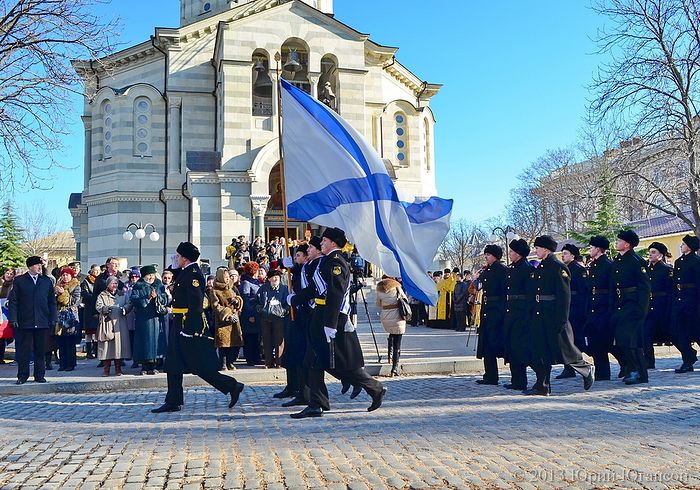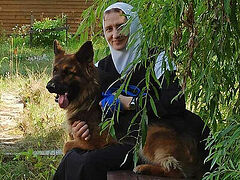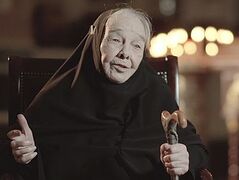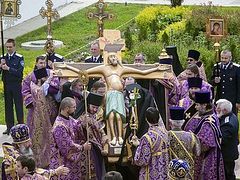Humility—this is how you could define the Godenovo Cross, which appeared in Russia in the fifteenth century and is now located at the dependency of the Pereslavl-St. Nicholas Convent in Godenovo.
It’s appearance in Russia can be compared to the appearance of the Iveron Icon of the Mother of God on Mt. Athos. “The Tale of the Appearance of the Honorable and Lifegiving Cross of the Lord” was written by an unknown priest who served in the Church of St. Nicholas the Wonderworker, where the wooden cross was located in the eighteenth century. Tradition testifies that the cross was revealed to shepherds in the Sakhta marshland near Rostov the Great in 1423: “And they (the shepherds) saw from the direction of Greece, from Heaven to Earth, an unspeakable light, and in the midst of the light in the air was the Lifegiving Cross of the Lord. Upon it was the image of the Crucified Lord, the face of God… and they heard a voice from the Crucified Lord, telling them: ‘The grace of God and the house of God will be in this place. If people come to pray with faith, there will be many healings and miracles from the Lifegiving Cross.’”
There have been many miracles. The Cross burned during in a fire in St. Nicholas Church and remained intact; it was desecrated in the 1930s, was taken out of the church, hidden by parishioners and again revealed to people. The Lifegiving Cross is currently in the Church of St. John Chrysostom in the village of Godenovo in the Yaroslav Province. And everything that happens around it can be called a miracle, given to Russia to maintain its power and strength.
This is confirmed by what happened recently: On the eve of the Maidan events in Ukraine, a copy of the Godenovo Cross was transferred to Crimea by request of the Orthodox.1
A cross procession with the Lifegiving Cross went along the main streets of Sevastopol, led by Metropolitan Lazar of Simferopol and Crimea and Admiral Alexander Vitko of the Black Sea Fleet. Flags of Sevastopol’s warship were festively blessed in front of the Cross, sailors were presented with icons depicting it, and the Cross was placed in the St. Vladimir’s Cathedral, in the crypt of Russian admirals. A few months later, the land of Crimea passed bloodlessly to Russia. On November 24, 2014, at the height of military operations in Ukraine, another copy of the Lifegiving Cross was made and given to Lugansk, to the Monastery of St. John the Forerunner. During the shelling, not a single bomb exploded in the monastery where the Cross is now kept, and no one died.
 Crimea greets the Godenovo Cross
Crimea greets the Godenovo Cross
For twenty years, the Church of St. John Chrysostom in Godenovo with its Lifegiving Cross has been a representation of the Pereslavl-St. Nicholas Convent.
The abbess of the monastery, Igumena Evstolia was born in St. Petersburg and received a higher art education. In 1988, with the blessing of her spiritual father, she arrived as a novice at the Holy Entrance of the Theotokos-Tolga Convent. She was a choir director, tour guide, bell ringer, and iconographer. She designed and restored the iconostasis of the Church of St. Nicholas the Wonderworker. In February 1994, with the blessing of Bishop Micah of Yaroslavl and Rostov, she went to the St. Nicholas Monastery. During Great Lent 1994, she received the monastic tonsure with the name Evstolia, in honor of St. Evstolia. Three months later she was established as the abbess, and three years later she was elevated to the rank of igumena by decree of His Holiness Patriarch Alexei II. She was awarded the jeweled cross in 2003 for her great work on the restoration of St. Nicholas Monastery.
***
We spoke with Mother Evstolia about the providence of God and human destinies, the miracles of the Godenovo Cross, and the essence of monastic life.
“I saw that Christ had a black face!”
 Abbess Evstolia (Afonina) —Mother, was it God’s providence that the Cross wound up in Crimea?
Abbess Evstolia (Afonina) —Mother, was it God’s providence that the Cross wound up in Crimea?
—We gave a copy of the Godenovo Cross to Crimea when it was peaceful there, before it became Russian. News broadcasts showed the Cross procession in Sevastopol and simultaneously, the raging Maidan in Kiev—as if two different countries. The Cross did its job. It was necessary to show the counterposition of Crimea in those days, and it was voiced at the highest level. Then the name “Godenovo Cross” was first heard from TV screens all over the country.
Just before Nativity 2014, a delegation from Lugansk came here—there was already bombing there and people had already died. “We need the Lifegiving Cross,” they said. And, amazingly, we had already made a wooden copy, but at the time we had no idea who we were making it for.
When the iconographer from Sergiev Posad finished his work, the Cross was brought to Pereslavl. The sisters and I solemnly lined up at the car, and when they took the Crucifix out, I saw… that Christ had a black face! I called the iconographer. “Why did you paint His face black?” I asked. “I repainted it thirty times,” the iconographer Nina said, “but then I realized I had to leave it that way.”
I looked at the sisters: They were tenderly praying and weeping. I realized then that it should be dark and it should be sent this way.
 Before sending the Cross to Lugansk
Before sending the Cross to Lugansk
I called the Monastery of the Nativity of St. John the Forerunner in the Lugansk Diocese. Archimandrite Bartholomew answered. I said: “The Cross your parishioners ordered is ready.” He said thank you and that he was going to come with the brothers to solemnly take the holy Cross. We set the date for November 26—the feast of St. John Chrysostom, the patronal feast of the church in Godenovo. They came for the Cross in a minibus, barely alive. I thought: “What a small car… How will the Cross fit in there?” But it fit. When we met six months later, Batiushka said: “I’m not a fan of talking about all kinds of miracles, but the face of Jesus has brightened.”
Miracles at the Cross
—Tell us about your first encounter with the Godenovo Cross.
—It is also one of God’s miracles. The Cross is famous now, and it’s hard to imagine there was a time when no one needed it and we didn’t know anything about it, although we’d been living in the Yaroslavl Diocese for eight years. It was some Muscovites that told us that we have this sacred item in the Rostov region, not far from the highway, in the forest.
It was summer and the sisters had long been asking for mushrooms and berries. We decided to go into the forest and go venerate the Cross at the same time. We loaded into the truck. We put benches in the back, and twelve people could fit. The village of Godenovo was thirty-five miles away.
It was a lovely day as we were driving up and saw the church standing on top a hill. The priest was there and opened the church. We went in, and there was—the Cross! We all stood, transfixed. We prayed. The sisters weren’t in a hurry to get anywhere. All thoughts disappeared… We didn’t pick any berries that day—we couldn’t leave the Cross. We asked Batiushka: “Could we organize a dependency here? We would sing, and read, and clean the church.” He said he would be glad because no one helps him and his matushka. I asked: “Do you have a place for us to lay our heads?” “Yes,” he said, “there’s a gatehouse near the cemetery.” Well, I thought: “A church, the Cross, a gatehouse—there’s already everything we need to start, and from there the Lord is in control!” This was 1996.
Now people ask me how I managed to “detach” such a dependency?! And I answer: “No one needed it!” The church was collapsing, it was under threat of closure due to lack of income, and the priest had to travel a long way to get there. Vladyka Micah tried to dissuade us: “Mother, do you need this Godenovo? So much gas you waste getting there. Where will you get money for the gas?” And I said: “We need it, Vladyka. We really need it!”
—Are you used to miracles, Mother?
—You have to get used to them, because they never cease. Really, we don’t know what’s a miracle and what’s not, and we think that’s normal. The Lord works miracles with you intimately, and it’s fearful to speak about it publicly. But sometimes you have to reveal a miracle, because like Doubting Thomas, we won’t believe until we touch it.
 The Godenovo Cross adorned for Lent We are collecting testimonies from parishioners about healings at the Cross. I’ll tell you about a few of them.
The Godenovo Cross adorned for Lent We are collecting testimonies from parishioners about healings at the Cross. I’ll tell you about a few of them.
A certain Praskovya came to visit us from Ukraine. She had fourth stage cancer. It was a miracle that she was able to make it to Godenovo. Then she went home, and she was going to die, but she put a little book with the akathist to the Lifegiving Cross under her pillow. She read it, and one wonderful day, she got up, completely healthy. Praskovya wrote us a letter with her medical records showing she was healthy.
Valentina from Lipetsk recalls: “I was busy with housework, and a film about the Godenovo Cross was on TV. My husband said: ‘Let’s go to Godenovo right away!’” She had a serious illness, and the doctors gave her no more than two months to live. They came and tearfully prayed at the Cross. The next day, a clinic was found in Moscow where she was taken for treatment. Three years have passed since then. Through Valentina’s sufferings, her entire family came to God and she asked that we tell about her healing, so many people would have hope. We have her medical records from before and after the Cross.
—The parishioners say that sometimes Christ’s feet are warm, sometimes cold…
—Each person receives the testimony he needs. Some say: “The Savior’s feet are warm!” Another says: “He looks at me with open eyes wherever I go.” Others object: “His eyes are closed,” and another: “He looks at me with blue eyes and evokes a deeper sense of repentance than I’ve ever felt before.” I think these are precious testimonies—people who feel that the Lord has touched their soul.
—When the theomachists came to close the churches in 1923, the Cross was trampled underfoot, doused with mud, and they wanted to destroy it. Why was there such hatred for the Cross?
—The country declared war on God and hated His relics, and this relic is the most significant. The Cross is the symbol of our faith, and the fiercest hatred for Christ is hatred for Christ on the Cross. Blasphemous abuse had to be poured out on the Cross, and it was poured out in abundance.
The sisters
—How could monastic life be revived in Rus’ after the last monastery was closed in Moscow in 1930?
—The life is built according to prophecies and the providence of God. Amazingly, it was precisely the 1,000th anniversary of the Baptism of Rus’ in 1988 that became a jumping-off point from which the lamps of monastic labor began to be lit.
—The first beauty contest was held in Moscow in 1988. Various opportunities opened up for soviet women during perestroika. Some went to work in the stores of some famous foreign companies, but you went to a monastery…
—Like the other sisters, I have a similar story. I graduated from college in 1988 expecting a respectable career, but the sense of the meaningless of everything that was being offered to me made me stop and think about the meaning of life.
It was a longing for God. I had no other thoughts in my heart except for the monastery, and the first convent in Russia was opening at that time, in Tolga.
How we needed it! Sixty-seven sisters came in just one year, and the next year just as many! The monastery was established: 125 sisters! It’s a behemoth! You can’t even imagine it now. What power of God must have been poured out on Russia in order to raise a monastery from the ashes and send nuns there from different places throughout vast Russia. Tolga, Kolomna, Khotkovo, Optina, Danilov, Shamordino—how many monasteries began to be revived across the face of the Russian land, and all around this date of the 1,000th anniversary of the Baptism of Rus’!
—Do you have to be born a nun?
 Abbess Evstolia —The title of monastic is given only by God. There are examples in history where people were forced to become monastics, but it’s impossible to force the head to burn with love for God. Although external monasticism can be conceived of as lack of sleep, prayer for three to four hours, meager food, work that brings no special pleasure—you just do what they say. You cut off your will in everything and curb your carnal thoughts. You pray again in the evening. Then you go to your cell where you are one-on-one with God. Your cell life begins, where you must pay your debt to God—alone in your cell. This is very important for our spiritual formation.
Abbess Evstolia —The title of monastic is given only by God. There are examples in history where people were forced to become monastics, but it’s impossible to force the head to burn with love for God. Although external monasticism can be conceived of as lack of sleep, prayer for three to four hours, meager food, work that brings no special pleasure—you just do what they say. You cut off your will in everything and curb your carnal thoughts. You pray again in the evening. Then you go to your cell where you are one-on-one with God. Your cell life begins, where you must pay your debt to God—alone in your cell. This is very important for our spiritual formation.
Our sisters used to live in twos or threes. Now, when St. Nicholas Monastery is already twenty-one years old, it’s very important for me as the abbess that the sisters who have been living in the monastery for a long time have separate cells.
A monastic should be able to face God one-on-one. We didn’t have this immediately, but it’s been seven years since we built a second building with cells for the sisters. Our cells are small. The bed, nightstand, and dresser are tiny, but the most important thing is that you close yourself up and remain alone.
—In 1994, five of you moved from the Tolga Monastery to the St. Nicholas Monastery. It was practically in ruins. Wasn’t it scary?
—In Pereslavl, I was warmed by the thought that we were close to St. Sergius. The Lavra is thirty-five miles away, and my spiritual father is there—Fr. Naum.2 Churches and monasteries are built with prayer and tears. Only once you have endured suffering does the Lord come to meet you. We have had spiritual guides and men of prayer in our life: Mother Theodosia (Kosorotikhina; † 2014), Alexei Fedorovich Astanin († 2012), Fr. Paul (Gruzdev; † 1996), and Blessed Lyuba Susaninskaya († 1997).
We weren’t afraid of anything; we didn’t take care for the morrow, but relied on God in everything. They let us take some furniture and potatoes and cabbage. There were many external difficulties—we didn’t notice the internal ones.
We came to the monastery not out of poverty or misery—the Lord called us to Himself and brought us.
 With His Holiness Patriarch Alexei, 1988
With His Holiness Patriarch Alexei, 1988
The most important thing for us was to open the doors of the churches and celebrate the services. The first Liturgy was served in the monastery two months later on the feast of the Annunciation. The Annunciation Church and bell tower was restored five years later, and ten years later the St. Nicholas Cathedral was reborn—powerful, in the tradition of fifteenth-century architecture.
Its main altar is dedicated to the Holy Hierarch and Wonderworker Nicholas; the right—to the founder of the monastery, St. Dmitry of Priluki; the left—to the Martyr Viktor, the Heavenly patron of the monastery’s benefactor Viktor Tirishkin.
The entrepreneur Viktor Ivanonivch Tirishkin took over the restoration of all the monastery buildings. The nuns believe that St. Nicholas himself brought him. This is his story: In his youth, returning from his parents’ house to St. Petersburg where he was studying in the Military Academy, he got in a car accident and miraculously survived. On his lap was a gift from his mother—an icon of St. Nicholas. After he grew up and became a successful businessman, he began to search for a monastery named for this saint that was in need of some help. Thus he ended up in Pereslavl at the St. Nicholas Convent. He took upon himself our lamentations, problems, pains, sorrows, and joys. There are few people in the world who participate so selflessly in Church life.
—Did the sisters that came with you from the Tolga monastery stay here?
—No, practically all of them dispersed to various places. The thing is that they knew me as an equal, and it’s difficult to recognize that someone is now above you—this requires God’s dispensation.
Fr. Naum started sending new sisters, and they began to perceive me as a mother, as an elder, and the entire sisterhood was gathered out of completely new residents. I taught some of them to pray the Lord’s Prayer; I sewed a skirt for some of them, because they arrived in pants; I started with the basics with many of them. The abbess of a monastery gathers under her wing precisely those who want to receive from her what they need for salvation. This is very important.
—Is a person’s personality revealed in a monastery?
—Of course, personalities are revealed in a monastery in an amazing way—all their talents are revealed.
As many sisters as we have, they all say: “I really didn’t think I’d be able to do this.” Sisters who have had no musical education become wonderful singers; those whose mothers didn’t let them in the kitchen, who sat in college reading books, are now excellent cooks. Some of them are revealed to have a talent for organization, others an artistic talent. [Many of the monastery’s icons were painted by the nuns, and the sisters of the St. Nicholas Monastery have started a school of writing—T.E.] A man is revealed for himself with God’s help—that’s for sure!
Prayer before the throne is the salt and foundation of our life in Jesus Christ. Like every Christian, monastics try to focus their lives on professing our faith. Coming to a monastery, we cannot immediately turn into different people, get away from our external cares—this process continues for years. Metanoia means change. We repent before God, and confession also means change. This is how a monastery is arranged. It is given Divine strength from above so the soul is perfected here.
Many say when you come to a monastery you find yourself in another world. It is in fact another world—both mystically and materially. It’s easy to breathe here and the heart comes to life.
—Mother, do you have any favorites among the sisters of the monastery?
—The holy fathers had their chosen children. When Elder Joseph the Hesychast reposed, no one doubted about who to give his relics to. Everyone was sure it was his cell attendant—Fr. Ephraim, his favorite spiritual child. Apparently you draw this or that person closer to yourself according to your degree of boldness and love for God. But that doesn’t mean any sisters should be deprived of my love. The monastery has a wonderful arrangement: on the one hand—a hierarchy, and on the other—everyone feels like God’s favorite.
—Have you ever regretted your chosen path?
—I regret that I didn’t come sooner! From birth!







